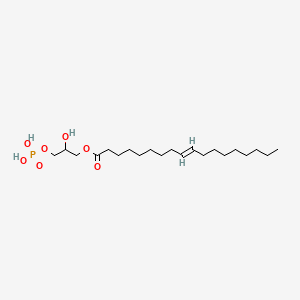| MeSH term | MeSH ID | Detail |
|---|---|---|
| Tuberculosis | D014376 | 20 associated lipids |
| Adenocarcinoma | D000230 | 166 associated lipids |
| Ovarian Neoplasms | D010051 | 10 associated lipids |
| Lung Neoplasms | D008175 | 171 associated lipids |
| Pulmonary Fibrosis | D011658 | 24 associated lipids |
| Pancreatic Neoplasms | D010190 | 77 associated lipids |
| Inflammation | D007249 | 119 associated lipids |
| Colonic Neoplasms | D003110 | 161 associated lipids |
| Diabetic Retinopathy | D003930 | 39 associated lipids |
| Mammary Neoplasms, Experimental | D008325 | 67 associated lipids |
lysophosphatidic acid
lysophosphatidic acid is a lipid of Glycerophospholipids (GP) class. Lysophosphatidic acid is associated with abnormalities such as Atherosclerosis, Alzheimer's Disease, Asthma, Diabetes Mellitus, Non-Insulin-Dependent and Septicemia. The involved functions are known as Inflammation, Chemotaxis, Binding (Molecular Function), Polymerization and Inflammatory Response. Lysophosphatidic acid often locates in Cytoskeleton, Microfilaments, actin cytoskeleton, Extracellular and Structure of germinal center of lymph node. The associated genes with lysophosphatidic acid are TNF gene, MAPK3 gene, RHOA gene, CDC42 gene and ADRBK1 gene. The related lipids are lysophosphatidic acid, Lipopolysaccharides, Lysophosphatidylcholines, Lysophospholipids and Phosphatidic Acid. The related experimental models are Knock-out, Transgenic Model, Rodent Model and Disease model.
Cross Reference
Introduction
To understand associated biological information of lysophosphatidic acid, we collected biological information of abnormalities, associated pathways, cellular/molecular locations, biological functions, related genes/proteins, lipids and common seen animal/experimental models with organized paragraphs from literatures.
What diseases are associated with lysophosphatidic acid?
lysophosphatidic acid is suspected in Atherosclerosis, Asthma, Dyslipidemias, Acute coronary syndrome, Pulmonary Fibrosis, Atherosclerosis of aorta and other diseases in descending order of the highest number of associated sentences.
Related references are mostly published in these journals:
| Disease | Cross reference | Weighted score | Related literature |
|---|
Possible diseases from mapped MeSH terms on references
We collected disease MeSH terms mapped to the references associated with lysophosphatidic acid
PubChem Associated disorders and diseases
What pathways are associated with lysophosphatidic acid
There are no associated biomedical information in the current reference collection.
PubChem Biomolecular Interactions and Pathways
Link to PubChem Biomolecular Interactions and PathwaysWhat cellular locations are associated with lysophosphatidic acid?
Visualization in cellular structure
Associated locations are in red color. Not associated locations are in black.
Related references are published most in these journals:
| Location | Cross reference | Weighted score | Related literatures |
|---|
What functions are associated with lysophosphatidic acid?
Related references are published most in these journals:
| Function | Cross reference | Weighted score | Related literatures |
|---|
What lipids are associated with lysophosphatidic acid?
Related references are published most in these journals:
| Lipid concept | Cross reference | Weighted score | Related literatures |
|---|
What genes are associated with lysophosphatidic acid?
Related references are published most in these journals:
| Gene | Cross reference | Weighted score | Related literatures |
|---|
What common seen animal models are associated with lysophosphatidic acid?
Knock-out
Knock-out are used in the study 'Source and role of intestinally derived lysophosphatidic acid in dyslipidemia and atherosclerosis.' (Navab M et al., 2015) and Knock-out are used in the study 'Lysophospholipid mediators in the vasculature.' (Mueller P et al., 2015).
Transgenic Model
Transgenic Model are used in the study 'Lysophosphatidic acid inhibits CD8 T cell activation and control of tumor progression.' (Oda SK et al., 2013).
Rodent Model
Rodent Model are used in the study 'Lysophosphatidic acid mediates fibrosis in injured joints by regulating collagen type I biosynthesis.' (Wu L et al., 2015).
Related references are published most in these journals:
| Model | Cross reference | Weighted score | Related literatures |
|---|
NCBI Entrez Crosslinks
All references with lysophosphatidic acid
Download all related citations| Authors | Title | Published | Journal | PubMed Link |
|---|---|---|---|---|
| Onallah H et al. | Activity and clinical relevance of autotaxin and lysophosphatidic acid pathways in high-grade serous carcinoma. | 2018 | Virchows Arch. | pmid:30032361 |
| Fukasawa K et al. | Qualitative and quantitative comparison of cyclic phosphatidic acid and its related lipid species in rat serum using hydrophilic interaction liquid chromatography with tandem-mass spectrometry. | 2018 | J Chromatogr A | pmid:30017223 |
| Zhou ZB et al. | Lysophosphatidic Acid Promotes Expression and Activation of Matrix Metalloproteinase 9 (MMP9) in THP-1 Cells via Toll-Like Receptor 4/Nuclear Factor-κB (TLR4/NF-κB) Signaling Pathway. | 2018 | Med. Sci. Monit. | pmid:30005060 |
| Zhu X et al. | Early development of porcine parthenogenetic embryos and reduced expression of primed pluripotent marker genes under the effect of lysophosphatidic acid. | 2018 | Reprod. Domest. Anim. | pmid:29974990 |
| Broström JM et al. | Toluene diisocyanate exposure and autotaxin-lysophosphatidic acid signalling. | 2018 | Toxicol. Appl. Pharmacol. | pmid:29940203 |
| Ueda H et al. | Involvement of lysophosphatidic acid-induced astrocyte activation underlying the maintenance of partial sciatic nerve injury-induced neuropathic pain. | 2018 | Pain | pmid:29939962 |
| Wang X et al. | Mutual regulation of the Hippo/Wnt/LPA/TGF‑β signaling pathways and their roles in glaucoma (Review). | 2018 | Int. J. Mol. Med. | pmid:29286147 |
| Nakajima S et al. | 2-O-Carba-oleoyl cyclic phosphatidic acid induces glial proliferation through the activation of lysophosphatidic acid receptor. | 2018 | Brain Res. | pmid:29278716 |
| Baader M et al. | Characterization of the properties of a selective, orally bioavailable autotaxin inhibitor in preclinical models of advanced stages of liver fibrosis. | 2018 | Br. J. Pharmacol. | pmid:29197066 |
| Takeda T et al. | In vivo evidence for possible up-regulating roles of lysophosphatidic acid around fertilization in rats. | 2018 | J. Vet. Med. Sci. | pmid:29162771 |
